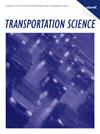用可解释可伸缩的非负张量分解理解始发目的地乘车需求
IF 4.8
2区 工程技术
Q1 OPERATIONS RESEARCH & MANAGEMENT SCIENCE
引用次数: 0
摘要
本文主要研究了基于始发目的地(OD)出行事件数据的出行需求估计与压缩。通过将OD事件数据表示为三向张量(原点、目的地和时间),我们将数据建模为具有强度张量的泊松过程,该强度张量可以根据Tucker分解进行分解。我们建立并证明了一种特定形式的非负类塔克张量分解,它通过K个潜在的原点空间因子和K个潜在的目的地空间因子来表示OD需求。然后,我们提供了一种计算和内存效率高的算法来执行这种分解,并演示了它在实时压缩和估计OD乘车需求方面的应用。以纽约市(NYC)出租车和华盛顿特区(DC)出租车为例进行了两个案例研究。实例研究结果表明,该方法在数据压缩和短期出行需求预测方面具有一定的适用性。此外,我们还发现,无论是纽约市还是华盛顿特区,学习到的潜在空间因素都是可解释的,并且局限于特定的区域。因此,该方法可以通过潜在的空间因素来理解OD出行数据,并用于识别OD出行的时空格局和总体的出行需求生成机制。本研究得到了美国交通部[UTC/NCST]和美国国家科学基金会[Grant DMS 1712996]的支持。补充材料:在线附录可在https://doi.org/10.1287/trsc.2022.0101上获得。本文章由计算机程序翻译,如有差异,请以英文原文为准。
Understanding Origin-Destination Ride Demand with Interpretable and Scalable Nonnegative Tensor Decomposition
This paper focuses on the estimation and compression of ride demand from origin-destination (OD) trip event data. By representing the OD event data as a three-way tensor (origin, destination, and time), we model the data as a Poisson process with an intensity tensor that can be decomposed according to a Tucker decomposition. We establish and justify a specific form of nonnegative Tucker-like tensor decomposition that represents OD demand via K latent origin spatial factors and K latent destination spatial factors. We then provide a computational and memory efficient algorithm for performing this decomposition and demonstrate its use for real-time compression and estimation of OD ride demand. Two case studies based on New York City (NYC) taxi and Washington DC (DC) taxi were implemented. Results from the case studies demonstrate the applicability of the proposed method in data compression and short-term forecast for ride demand. Furthermore, we found that the learned latent spatial factors are interpretable and localized to specific areas for both NYC and DC cases. Hence, this method can be used to understand OD trip data through latent spatial factors and be used to identify spatio-temporal patterns for OD trip and travel demand generation mechanism in general. Funding: This work was supported by the U.S. Department of Transportation [UTC/NCST] and the U.S. National Science Foundation [Grant DMS 1712996]. Supplemental Material: The online appendix is available at https://doi.org/10.1287/trsc.2022.0101 .
求助全文
通过发布文献求助,成功后即可免费获取论文全文。
去求助
来源期刊

Transportation Science
工程技术-运筹学与管理科学
CiteScore
8.30
自引率
10.90%
发文量
111
审稿时长
12 months
期刊介绍:
Transportation Science, published quarterly by INFORMS, is the flagship journal of the Transportation Science and Logistics Society of INFORMS. As the foremost scientific journal in the cross-disciplinary operational research field of transportation analysis, Transportation Science publishes high-quality original contributions and surveys on phenomena associated with all modes of transportation, present and prospective, including mainly all levels of planning, design, economic, operational, and social aspects. Transportation Science focuses primarily on fundamental theories, coupled with observational and experimental studies of transportation and logistics phenomena and processes, mathematical models, advanced methodologies and novel applications in transportation and logistics systems analysis, planning and design. The journal covers a broad range of topics that include vehicular and human traffic flow theories, models and their application to traffic operations and management, strategic, tactical, and operational planning of transportation and logistics systems; performance analysis methods and system design and optimization; theories and analysis methods for network and spatial activity interaction, equilibrium and dynamics; economics of transportation system supply and evaluation; methodologies for analysis of transportation user behavior and the demand for transportation and logistics services.
Transportation Science is international in scope, with editors from nations around the globe. The editorial board reflects the diverse interdisciplinary interests of the transportation science and logistics community, with members that hold primary affiliations in engineering (civil, industrial, and aeronautical), physics, economics, applied mathematics, and business.
 求助内容:
求助内容: 应助结果提醒方式:
应助结果提醒方式:


